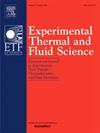Heating at different zones on the airfoil: Experimental study on boundary layer flow and convection heat transfer scaling
IF 2.8
2区 工程技术
Q2 ENGINEERING, MECHANICAL
Experimental Thermal and Fluid Science
Pub Date : 2025-02-22
DOI:10.1016/j.expthermflusci.2025.111445
引用次数: 0
Abstract
For future wing layouts and delicate laminar-wing aircraft with full-surface anti-/de-icing requirements, electric heating technology offers the advantages of flexible heating positions, high thermal efficiency and environmental friendliness. However, in addition to achieving good protection, advanced anti-de-icing technology must also take into account the requirements of efficient aerodynamic design. To investigate the effects of different heating zones on heat transfer efficiency and flow pattern within the boundary layer of wing, 15 heating zones based on bus temperature control were constructed on the leading edge and upper surface of the NACA2412 standard airfoil model, and a wind tunnel test framework was built for the study of electro-thermal convection. This is because accurate quantification of the heat transfer efficiency and precise identification of the flow effects in the boundary layer, which are crucial for effective thermal management and satisfying aerodynamic design. Within the airfoil boundary layer, test results from four typical flow characterization zones were selected for elucidation, and the spatial distribution of velocity and temperature induced by each heating zone were quantitatively characterized. Subsequently, the convective heat transfer efficiency in each heat affected zone was demonstrated using convective heat resistance. The results show that: abrupt changes in the flow state of the boundary layer can have a significant truncation effect on the temperature distribution of the flow field, leading to significant differences in the heat diffusion and heat transfer efficiency in the influence aera; moderate heating before the boundary layer burst can effectively delay the end position of the transition; and the temperature boundary layer conditions show a bimodal peak after localized heating in the airfoil. The experimental data elucidate the effects of heating at different zones on the airfoil boundary, and this work contributes to non-isothermal flow field simulation and anti-deicing design.
翼型不同区域加热:边界层流动与对流换热结垢的实验研究
对于未来机翼布局和具有全表面防/除冰要求的精致层流翼飞机,电加热技术具有加热位置灵活、热效率高和环境友好的优点。然而,先进的防除冰技术除了要实现良好的防护外,还必须考虑到高效气动设计的要求。为了研究不同加热区对机翼边界层内换热效率和流动形态的影响,在NACA2412标准翼型模型前缘和上表面构建了15个基于客车温度控制的加热区,并搭建了研究电热对流的风洞试验框架。这是因为准确量化传热效率和精确识别边界层内的流动效应对于有效的热管理和满足气动设计至关重要。选取翼型附面层内4个典型流动表征区的试验结果进行分析,定量表征了各加热区的速度和温度空间分布。随后,利用对流热阻论证了各热影响区的对流换热效率。结果表明:边界层流动状态的突变会对流场温度分布产生明显的截断效应,导致影响区域内的热扩散和换热效率存在显著差异;边界层爆发前的适度加热可以有效地延缓过渡的结束位置;温度边界层条件在翼型局部加热后呈现双峰峰。实验数据阐明了不同区域加热对翼型边界的影响,为非等温流场模拟和防除冰设计提供了理论依据。
本文章由计算机程序翻译,如有差异,请以英文原文为准。
求助全文
约1分钟内获得全文
求助全文
来源期刊

Experimental Thermal and Fluid Science
工程技术-工程:机械
CiteScore
6.70
自引率
3.10%
发文量
159
审稿时长
34 days
期刊介绍:
Experimental Thermal and Fluid Science provides a forum for research emphasizing experimental work that enhances fundamental understanding of heat transfer, thermodynamics, and fluid mechanics. In addition to the principal areas of research, the journal covers research results in related fields, including combined heat and mass transfer, flows with phase transition, micro- and nano-scale systems, multiphase flow, combustion, radiative transfer, porous media, cryogenics, turbulence, and novel experimental techniques.
 求助内容:
求助内容: 应助结果提醒方式:
应助结果提醒方式:


